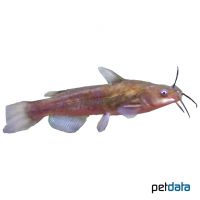Wels Catfish (Silurus glanis)
| Wels Catfish Silurus glanis | |
|---|---|
| Name | Wels Catfish |
| Name Lat. | Silurus glanis |
| Family | Sheatfishes |
| Family lat. | Siluridae |
| Order | Catfishes |
| Order lat. | Siluriformes |
| Origin | Europe, Asia |
| Habitat | Rivers, lakes, estuaries |
| Diet | Carnivore |
| pH | 7.0-7.5 |
| Behavior | Predatory |
| Keeping | Individual |
| Care Level | Experts only |
| Reproduction | Substrate spawner |
| Breeding | Moderately difficult |
| Life Span | 30-40 years |
| Protection | No |
| Metric Units | |
| Size | 90-100 cm |
| Temperature | 4-22 °C |
| Hardness | < 10 °dH |
| Aquarium | Pond |
| US Units | |
| Size | 35"-39" |
| Temperature | 39-72 °F |
| Hardness | < 178 ppm |
| Aquarium | Pond |
Distribution and habitat
The distribution range of the predominantly nocturnal European catfish extends from Central and Eastern Europe through Asia Minor to the Caspian Sea. They live in plant-rich warm lakes, deep slow-flowing rivers with soft, muddy bottoms, and in the brackish water of estuaries, where they spend most of their time during the day hiding in caves or in the root network of trees
Maintenance
A very large pond is recommended, which should be furnished with pond, floating and oxygenating underwater plants (milfoil, waterweed, hornwort, etc.), large river pebbles with numerous hiding places, as well as a soft substrate of round-grained gravel and sand suitable for burrowing, and offer free swimming space.
No ammonia, ammonium or nitrite should be detectable in the water, and the nitrate value should not exceed 100 mg/l. To ensure the water quality and oxygen content, a filter adapted to the water volume is necessary.
Diet
They are greedy and voracious predators that feed on fish, frogs, small water birds and small mammals. According to their size, the food supply consists of insect larvae, snails, mussels, earthworms, crayfish, fish, etc., which is easily accepted even frozen, as well as beef heart and sinking dry food for pond fish (catfish pellets)
It should in no case be fed daily and only as much as is eaten within a few minutes
Behaviour and compatibility
The juveniles live in a shoal, but adults behave very aggressively within the species. Only in sufficiently large ponds several European Catfish can be kept together. Socialization is only possible with large and defensible fish, as they will eat anything that fits in their large mouths.
Basically, only mutually compatible fish species with similar requirements for water quality and water temperature may be socialized.
Reproduction and breeding
No external distinguishing characteristics are known. At spawning time, the females appear somewhat rounder.
They spawn between May and July at a water temperature of at least 18 °C. The female lays the 1.4-2 mm eggs, which are guarded by the male, in a self-made shallow bottom pit in the plant-covered shore area. After 2-5 days the larvae hatch and brood care ends. The young fish grow very quickly and are sexually mature after 2-3 years. In nature they can live up to 80 years, in captivity over 10 years.
Important
European catfish, the largest freshwater fish in Europe, forage primarily in the evening or at night. They have an excellent sense of smell and taste, and the animals' extremely sensitive hearing is specialized for sounds above the water surface.
If they are overwintered in the pond, sufficient depth and oxygen supply (filter, oxygen dispenser, ice free holder) must be ensured.
At temperatures below 8-10 °C, the metabolism of the fish slows down and food is no longer accepted; feeding must be stopped accordingly. If the temperature drops further, they hibernate near the bottom. In spring, with rising temperatures, feeding can slowly be resumed. Feeding may also be necessary during prolonged warm periods in winter.
The well-being of the fish should be monitored regularly. A regular partial water change, according to the pond size is recommended, even if the pollutant load has not yet reached the upper limit. Sudden changes in water quality should be avoided. Newly introduced fish must be accustomed to the water slowly
Further literature can be found in your pet store.
References
Text: Werner Winter; Image: Franz Lowak
Source: BMELV (1998): Tierschutzgutachten - Haltung von Zierfischen (Süßwasser); RIEHL & BAENSCH (2006): Aquarien Atlas Bd. 3, Mergus Verlag; ENGELMANN (2005): Zootierhaltung - Tiere in menschlicher Obhut: Fische, Verlag Harri Deutsch
- Gemäß § 21 Abs. 5 Tierschutzgesetz idgF
